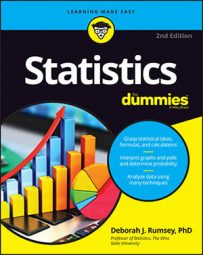In statistics, numerical random variables represent counts and measurements. They come in two different flavors: discrete and continuous, depending on the type of outcomes that are possible:
Discrete random variables. If the possible outcomes of a random variable can be listed out using a finite (or countably infinite) set of single numbers (for example, {0, 1, 2 . . . , 10}; or {-3, -2.75, 0, 1.5}; or {10, 20, 30, 40, 50…} ), then the random variable is discrete.
Continuous random variables. If the possible outcomes of a random variable can only be described using an interval of real numbers (for example, all real numbers from zero to ten ), then the random variable is continuous.
Discrete random variables typically represent counts — for example, the number of people who voted yes for a smoking ban out of a random sample of 100 people (possible values are 0, 1, 2, . . . , 100); or the number of accidents at a certain intersection over one year's time (possible values are 0, 1, 2, . . .).
Discrete random variables have two classes: finite and countably infinite. A discrete random variable is finite if its list of possible values has a fixed (finite) number of elements in it (for example, the number of smoking ban supporters in a random sample of 100 voters has to be between 0 and 100). One very common finite random variable is obtained from the binomial distribution.
A discrete random variable is countably infinite if its possible values can be specifically listed out but they have no specific end. For example, the number of accidents occurring at a certain intersection over a 10-year period can take on possible values: 0, 1, 2, . . . (in theory, the number of accidents can take on infinitely many values.).
Continuous random variables typically represent measurements, such as time to complete a task (for example 1 minute 10 seconds, 1 minute 20 seconds, and so on) or the weight of a newborn. What separates continuous random variables from discrete ones is that they are uncountably infinite; they have too many possible values to list out or to count and/or they can be measured to a high level of precision (such as the level of smog in the air in Los Angeles on a given day, measured in parts per million).

